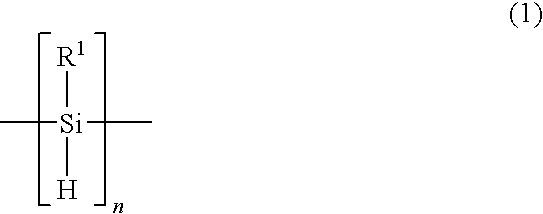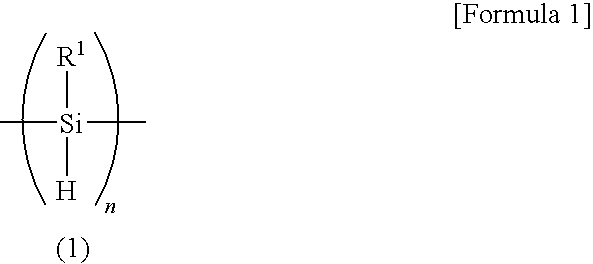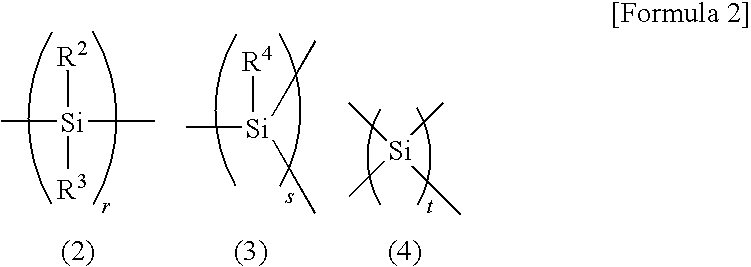Polysilane and polysilane-containing resin composition
a technology of polysilane and resin composition, which is applied in the direction of coatings, etc., can solve the problems of difficult to impart other functions to the polysilane or control the physical properties of the polysilane, difficult to synthesize in large quantities, and high cost of chlorosilane compounds having other structures, etc., to achieve excellent functionality of the polysilane, easy and efficient production
- Summary
- Abstract
- Description
- Claims
- Application Information
AI Technical Summary
Benefits of technology
Problems solved by technology
Method used
Image
Examples
example 1
[0178]To a round flask (internal volume: 1000 ml) equipped with a three-way stopcock, 25 g of granular magnesium (particle size: 20 to 1000 μm) and 20 g of lithium chloride as a catalyst were fed, and the internal of the reaction vessel (flask) was dried with heating at 50° C. under a reduced pressure of 1 mmHg (=133 kPa). Thereafter, dry argon gas was introduced into the reaction vessel, 500 ml of tetrahydrofuran (THF) pre-dried with sodium-benzophenone ketyl was added thereto, and the mixture was stirred at 25° C. for about 60 minutes. To the reaction mixture were added 63.5 g (0.3 mol) of phenyltrichlorosilane purified by distillation and 34.5 g (0.3 mol) of methyldichlorosilane purified by distillation by the use of a syringe, and the resulting mixture was stirred at 25° C. for about 24 hours. After completion of the reaction, 1000 ml of 1N (=1 mol / L) hydrochloric acid was put in the reaction mixture, and the reaction mixture was subjected to extraction with 500 ml of toluene. T...
example 2
[0180]In the same manner as Example 1 except for using 3.7 g (50 mmol) of acrylic acid instead of 5.0 g of ethyl acrylate in Example 1, 11.2 g of a copolysilane having a carboxyl group was obtained (yield: 100%).
example 3
[0181]In the same manner as Example 2 except for using 0.061 g of dibenzoyl peroxide instead of 0.41 g of AIBN in Example 2, 11.2 g of a copolysilane having a carboxyl group was obtained (yield: 100%).
PUM
| Property | Measurement | Unit |
|---|---|---|
| temperature | aaaaa | aaaaa |
| mean particle size | aaaaa | aaaaa |
| mean particle size | aaaaa | aaaaa |
Abstract
Description
Claims
Application Information
 Login to View More
Login to View More - R&D
- Intellectual Property
- Life Sciences
- Materials
- Tech Scout
- Unparalleled Data Quality
- Higher Quality Content
- 60% Fewer Hallucinations
Browse by: Latest US Patents, China's latest patents, Technical Efficacy Thesaurus, Application Domain, Technology Topic, Popular Technical Reports.
© 2025 PatSnap. All rights reserved.Legal|Privacy policy|Modern Slavery Act Transparency Statement|Sitemap|About US| Contact US: help@patsnap.com



